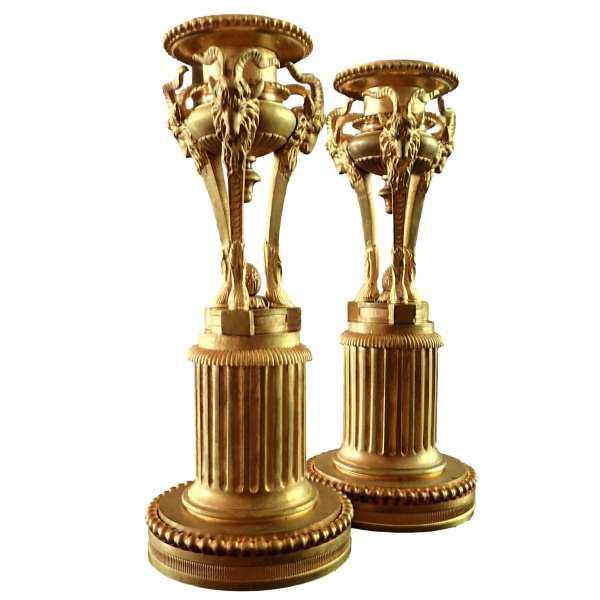Lovely Pair Of Rove Goat Decorated French Gilt Bronze Candlesticks

An absolutely charming Pair of small Candlesticks in chased and gilded bronze in the shape of an Athenian with delicate chased bronze figures of Goats standing on a fluted column shaft.
Done in the louis XVI Style but dating probably to the French Restoration Period these two candlesticks are particularly dear to us because of the goat represented on them.
With its very distinct curved horns this is a representation of the Rove Goat.
Separated from L’Estaque by steep mountains that are crossed by a tunnel, the village of Le Rove is the obligatory passage when leaving Marseille from the west.
The road avoids the village which seems to be far from the sea. But a road leads to the creeks of La Vesse and Niolon, which face Marseille and the islands of the Frioul archipelago.
Hence when you are driving out of Marseille you come close to the cliffs of the Rove, where you will often see these sturdy little goats grazing on the differents shrubs that grow in this wild terrain.
They serve a double purpose: clearing the side of the hills and taking care of the undergrowth, and producing a wonderfullly flavored milk which is turned into a great cheese! The Brousse du rove!
The Rove goat is an original goat (Capra aegagnus Prisca).
This ‘caprid’ is armed with remarkable horns, twisted, and lyre-shaped, with the horns of some billy-goats can reach a span of 1m20.
These characteristics give them a particular elegance and presence. The hair is short and soft, the dresses are varied. They can be red or black (these colors are dominant in the herds), but there are also “blaù” (grey ash), “cardalines” (red speckled with white), “sardines” (red mixed with gray), “boucabelles” (black with fire in the ears, under the eyes, the muzzle and the end of the legs), “Tchaîsses” (black in front, red in back).
Two hypotheses explain their presence in the Rove massif near Marseille. This goat having as distant origin of Mesopotamia, Anatolia and of course Greece, they would have been imported by the Phoenicians on board a ship that would have sunk along the coast of the Rove. A large part of these goats would have swum to the coast, to be then domesticated by the shepherds of the Rove which have present for millennia. For the second hypothesis, the goats of the Rove would have arrived by sea to the port of Marseille on board of Phoenicians boats and adopted or purchased by the shepherds of Rove.
It is only over the centuries by a natural and ruthless selection in the Rove hills, that this goat was shaped and took the name of its land which became its cradle of origin …
The Chèvre du Rove was born!…
Our charming Candlesticks are a perfect homage to the lovely goats!
France 19th Century c.H: 6 3/4"Reference number: R-410
Click here to print.
go back
